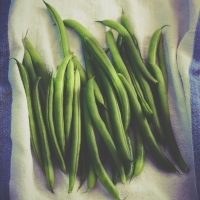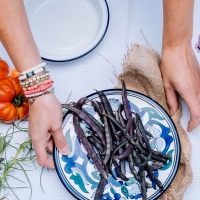Green beans
Introduction
Common beans (green beans, kidney beans and other varieties of Phaseolus vulgaris) have been a staple food for many thousands of years for various cultures across the globe. Beside their great nutritional value, what makes beans a valuable food product is their ability to grow almost anywhere in all climatic conditions. Common bean can be used as dry or fresh seeds but also as immature pods that could be of various colors, green, yellow and purple and presenting many different shapes. Common beans used as fresh pods are known as Snap beans and are also known with many different names, including green beans, French beans, stringless beans, fagiolini and haricots verts.
Classification and taxonomy
Following the botanical classification, the common beans belong to the Fabaceae family and to the Phaseolus vulgaris species.
Origin, history and uses
The wild ancestor of the common beans (Phaseolus vulgaris) originated in what is now Mesoamerica and then spread in South America. Domestication occurred independently in Mesoamerica and South America around 8,000.12
Phaseolus vulgaris was introduced to the Old world for the first time by Christopher Columbus, upon his return from the second trip to the New World in 1493.
Key facts about beans
According to FAOSTAT3, the leading global producers of green beans are China, Indonesia and Turkey. Within the European Union, Spain, Italy and Belgium are the most important green bean growers.
All beans, including the green beans, contribute to environment sustainability due to their biological nitrogen fixation, their beneficial effects on soil and the control of weeds.
Green beans are rich in vitamin (i.e. vitamin C, K, A, B3, etc), fibers, calcium and Omega-3 fats. They can be consumed fresh or frozen in various meals.
Bitocchi E, Nanni L, Bellucci E, Rossi M, Giardini A, Spagnoletti Zeuli P, Logozzo G, Stougaard J, Mcclean P, Attene G, Papa R (2012) Mesoamerican origin of the common bean (Phaseolus vulgaris L.) is revealed by sequence data. Proceedings of the National Academy of Sciences of the United States of America, 109: E788-E796. ↩
Bitocchi E, Bellucci E, Giardini A, Rau D, Rodriguez M, Biagetti E, Santilocchi R, Spagnoletti Zeuli P, Gioia T, Logozzo G, Attene G, Nanni L, Papa R (2013) Molecular analysis of the parallel domestication of the common bean in Mesoamerica and the Andes. New Phytologist, 197: 300-313. ↩
Food and Agricultural Organisation of the United Nations, Statistics Division: Statistics about the green bean global production are available at http://www.fao.org/faostat/en/#data/QC/visualize, last consulted August 30th, 2018. ↩
Fun facts

Did you know that…the green bean was introduced to Europe, namely the Mediterranean countries, by Christopher Columbus, upon his return from the second trip to the New World in 1493?

Did you know that…green beans could be magic? Just remember the bean seeds bought from the village market by the little Jack in the English fairy tale “Jack and the beanstalk”?

Did you know that…beans have their own day in the United States? Americans celebrate the National Bean Day on January 6th. Apparently, this day was created to commemorate the death of the famous scientist Gregor Mendel who used peas and beans in his experiments that brought him to the laws of genetic inheritance.